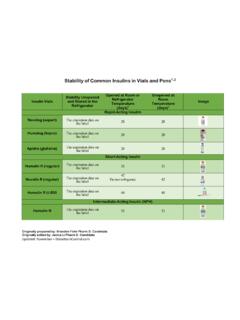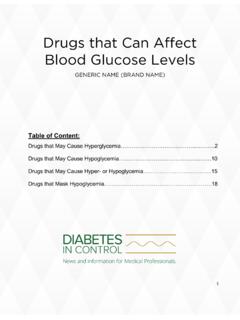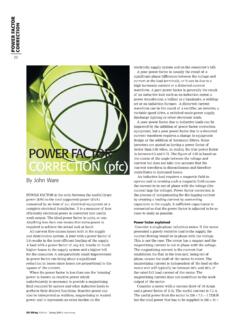Transcription of DETERMINING YOUR INSULIN SENSITIVITY FACTOR
1 DETERMINING your INSULIN SENSITIVITY FACTOR your INSULIN SENSITIVITY FACTOR , sometimes referred to as your correction FACTOR or correction bolus, is the mg/dl drop in your blood glucose caused by 1 unit of INSULIN . There will be times when you need to make INSULIN adjustments to keep your blood glucose within target. Sometimes, you will need to add more INSULIN at a mealtime to correct for a high blood glucose. Other times, you may want to correct a high blood glucose outside of a meal time. In either case, you ll need to know how many mg/dl one unit of INSULIN lowers your blood glucose level.
2 The right correction bolus will return your blood glucose to within 30 mg/dl of your target blood glucose about 3 hours after you ve given the dose. Keep in mind that your SENSITIVITY FACTOR may vary throughout the day or during times of illness. CALCULATING your SENSITIVITY FACTOR / correction FACTOR Total amount of INSULIN per day: (use a three day average) Basal daily total: _____units + Bolus daily total: _____units + Total Daily INSULIN : _____units Divide: 1700 by Total Daily INSULIN . This is your SENSITIVITY FACTOR / correction FACTOR . Example: 14 units basal INSULIN + 16 units bolus INSULIN = 30 units total daily INSULIN 1700/30 = 50.
3 This correction FACTOR means that 1 unit of INSULIN will lower blood glucose by approximately 50mg/dl. HOW TO USE THE correction FACTOR TO CALCULATE A correction BOLUS: correction Bolus Formula: (Current BG) - (Target BG) = correction bolus dose ( correction FACTOR ) Example: Current BG = 200 mg/dl Target BG = 100 mg/dl correction = 50 So, 200-100 = units of INSULIN for a correction dose 50 TESTING your SENSITIVITY FACTOR / correction FACTOR Choose a time to test when.
4 your blood glucose value is at least 50 mg/dl above your target You have not taken a meal bolus or correction bolus for at least 4 hours You have not eaten any food for the last 4 hours You can go without eating for the next 4 hours Don t test your correction FACTOR during any circumstances that might affect the results, such as: After performing strenuous exercise If you have an illness or infection After a serious low blood glucose During major emotional stress Here are the steps to follow to test your correction FACTOR : 1. Check and record your blood glucose 2.
5 Take a correction bolus based on your current SENSITIVITY FACTOR / correction FACTOR 3. Test your blood glucose at 2, 3 and 4 hours after taking the bolus. Record your blood glucose values at these times: your blood glucose values should be going down If you drop below 70 mg/dl at any time during the test, treat the low and stop the test. You will want to consult with your healthcare provider about an adjustment in your correction FACTOR (you may need less INSULIN ) 4. If your blood glucose is within 30mg/dl of your target blood glucose 4 hours after the dose, try using this same correction FACTOR again to confirm that it is correct.
6 If your blood glucose is > 30 mg/dl of your target blood glucose 4 hours after the dose, repeat the test again with a smaller INSULIN SENSITIVITY FACTOR / correction FACTOR . If your blood glucose is < 30 mg/dl of your target blood glucose 4 hours after the dose, repeat the test again with a larger INSULIN SENSITIVITY FACTOR / correction FACTOR . 5. Repeat this test until you have determined your SENSITIVITY FACTOR / correction FACTOR and then repeat it one more time to confirm the results. The worksheet on the next page may help you to do this testing. Courtesy of 11/22/09








